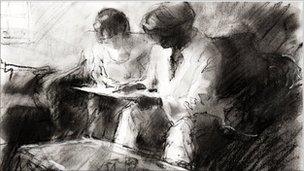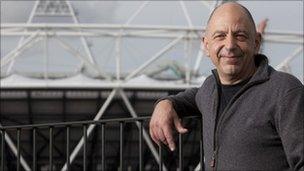What do artists-in-residence do?
- Published
.jpg)
David Downton will illustrate Claridge's famous guests
Author Tony Parsons has taken up residency at Heathrow Airport where he will be roaming its terminals and air traffic control centre to find inspiration for a series of short stories.
The airport is the latest business to engage an artist-in-residence.
In a top-secret mission, painter James Hart Dyke was required to spy on MI6, sketchbook in hand, as he watched the agents at work.
London Zoo, as well as numerous cathedrals and universities, have also got in on the act.
But what is the role of an artist-in-residence?
Artist Neville Gabie has been chronicling the transformation of east London in the run-up to the Olympics.
"My role is to make what's happening on the park behind the boardings visible to a wider audience that wouldn't have that access," he said.
"I'm trying to show the many jobs and tasks in hand which would otherwise go unseen."
His 16-month residency has seen him capture the site's changes with numerous short films, sculptures and photographs.
"People's focus will be on big moments, like the stadiums and the games, but I want to show how it got to that point."
For years Prince Charles has taken artists with him on his international tours.

James Hart Dyke's work at MI6 aimed to capture the essence of an agent's life
Paid for out of his own pocket, the prince is an "enabler who has tour artists to record contemporary life", says landscape painter Alan Cotton who travelled with him on a tour to Fiji, Australia and New Zealand in 2005.
"It's very different [from working in a studio], as when on tour, you have to work very quickly on the move, and work very hard," he said.
A tour artist's role is different from that of the journalists and photographers who accompany royalty on such visits, as Cotton's task was "to record the life that we saw and were part of" rather than of the prince himself.
"In contemporary society artists have a place. Thousands of photographs are taken of war zones and conflict, and artists have a unique way of looking at them.
"A lot of photographers have no involvement with the thing they're looking at; an artist has to involve himself in a more substantial way."
Being an artist-in-residence has its perks.
For Cotton, being on tour with the prince meant he could meet fascinating people, and as he was able to go to many events it was a great education.
Tony Parsons said he will be "spoiled for choice" for subject matter as Heathrow Airport's new writer-in residence
Russell Martin, from Artquest, a service which provides support to artists, said residences were highly sought after.
Some may call for artists to produce work on a specific topic, such as the construction of the Olympics site, while others may offer artists accommodation and access to studios for them to work on pieces for an exhibition.
"Making a living as an artist has always been a precarious thing. Recent research has found that the average income in London of an artist was £15,000 a year, which is substantially below the median earning threshold, so artists are finding lots of different ways to make money," he said.
'One-off' occasion
Luxury hotel Claridge's has recently commissioned illustrator David Downton to be its first ever artist-in-residence.
"His work is particularly timeless and elegant, qualities we believe are also reflected in our hotel," said general manager Thomas Kochs.

Artist Neville Gabie is chronicling the construction of the Olympic park in east London
"Some of our particularly distinguished guests are regularly captured by photographers and paparazzi. We wanted them to feel that this was a more special one-off occasion, being drawn by a skillful and talented artist.
"As David Downton is a regular visitor of the hotel and we have long admired his work, this seemed a natural step."
The hotel is normally captured in paparazzi snapshots, so he hopes by having an illustrator on site, the more glamorous and ethereal side of the hotel will be conveyed.
There are things artists should be wary of, said Mr Martin, so that companies do not use them as a cheap way of getting PR.
"Residences do not mean one thing to everyone; there is scope for companies to imagine it how they like and use it to exploit artists to do work which otherwise they would have to pay for," he said.
Mr Gabie, who has also undertaken a three-year residency commissioned by a private company to chronicle the building of Cabot Circus shopping centre in Bristol, said he always had full autonomy to produce what he wanted.
"Although I'm given access, I'm not there as a spokesperson for the Olympic Development Agency. I'm independent in what I express, and if my role was simply to be an additional press person for the ODA I would be failing in my job.
"They don't vet what I do, and I have conversations regularly. It's a strength of an organisation to be able to invite an artist in."
Claridge's does, however, have some stipulations as to what Downton can illustrate.
"We have complied a 'secret' wish list of guests we would like David to draw at Claridge's. They will all be friends of the hotel and have been coming through our revolving door over the years," said Mr Kochs.
"We respect David's skill as an artist and will of course give him creative freedom with his experienced judgment. The chosen list reflects the timelessness of Claridge's, and they are style icons in their own right, whether from the world of fashion, film or the arts."
- Published4 August 2011
- Published2 August 2011
- Published14 November 2010